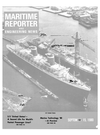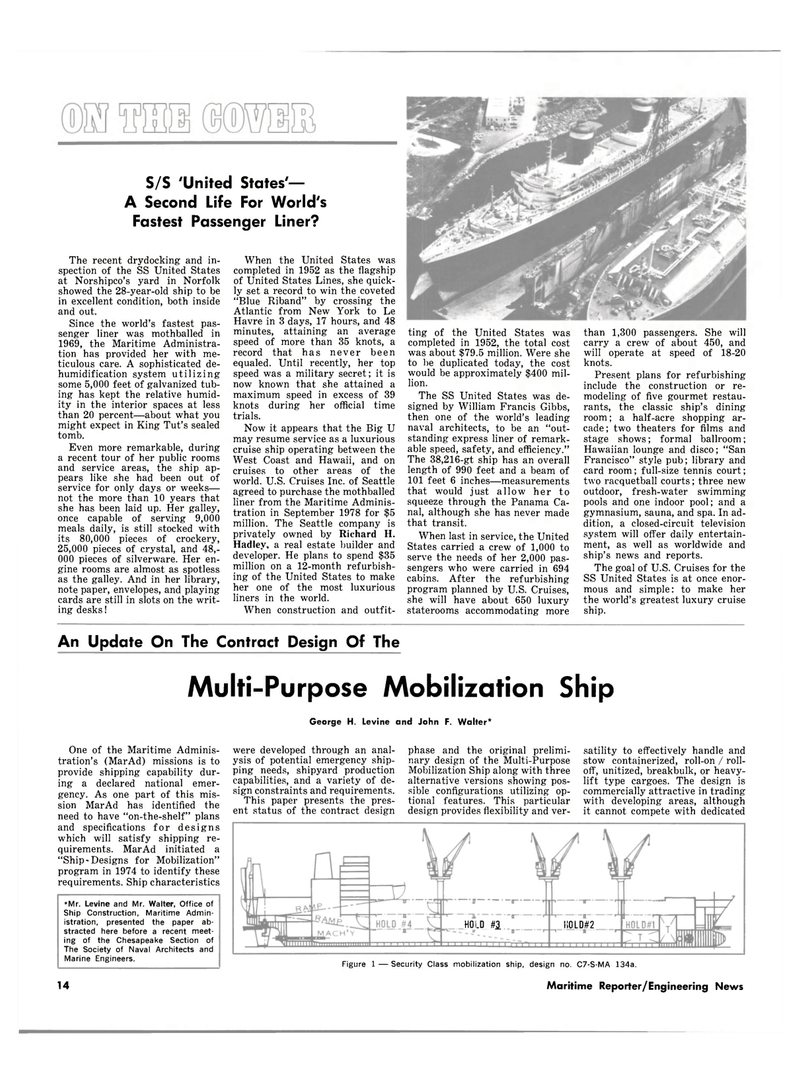
Page 12: of Maritime Reporter Magazine (September 15, 1980)
Read this page in Pdf, Flash or Html5 edition of September 15, 1980 Maritime Reporter Magazine
S/S 'United States'—
A Second Life For World's
Fastest Passenger Liner?
The recent drydocking and in- spection of the SS United States at Norshipco's yard in Norfolk showed the 28-year-old ship to be in excellent condition, both inside and out.
Since the world's fastest pas- senger liner was mothballed in 1969, the Maritime Administra- tion has provided her with me- ticulous care. A sophisticated de- humidification system utilizing some 5,000 feet of galvanized tub- ing has kept the relative humid- ity in the interior spaces at less than 20 percent—about what you might expect in King Tut's sealed tomb.
Even more remarkable, during a recent tour of her public rooms and service areas, the ship ap- pears like she had been out of service for only days or weeks— not the more than 10 years that she has been laid up. Her galley, once capable of serving 9,000 meals daily, is still stocked with its 80,000 pieces of crockery, 25,000 pieces of crystal, and 48,- 000 pieces of silverware. Her en- gine rooms are almost as spotless as the galley. And in her library, note paper, envelopes, and playing cards are still in slots on the writ- ing desks!
When the United States was completed in 1952 as the flagship of United States Lines, she quick- ly set a record to win the coveted "Blue Riband" by crossing the
Atlantic from New York to Le
Havre in 3 days, 17 hours, and 48 minutes, attaining an average speed of more than 35 knots, a record that has never been equaled. Until recently, her top speed was a military secret; it is now known that she attained a maximum speed in excess of 39 knots during her official time trials.
Now it appears that the Big U may resume service as a luxurious cruise ship operating between the
West Coast and Hawaii, and on cruises to other areas of the world. U.S. Cruises Inc. of Seattle agreed to purchase the mothballed liner from the Maritime Adminis- tration in September 1978 for $5 million. The Seattle company is privately owned by Richard H.
Had ley, a real estate builder and developer. He plans to spend $35 million on a 12-month refurbish- ing of the United States to make her one of the most luxurious liners in the world.
When construction and outfit- ting of the United States was completed in 1952, the total cost was about $79.5 million. Were she to be duplicated today, the cost would be approximately $400 mil- lion.
The SS United States was de- signed by William Francis Gibbs, then one of the world's leading naval architects, to be an "out- standing express liner of remark- able speed, safety, and efficiency."
The 38,216-gt ship has an overall length of 990 feet and a beam of 101 feet 6 inches—measurements that would just allow her to squeeze through the Panama Ca- nal, although she has never made that transit.
When last in service, the United
States carried a crew of 1,000 to serve the needs of her 2,000 pas- sengers who were carried in 694 cabins. After the refurbishing program planned by U.S. Cruises, she will have about 650 luxury staterooms accommodating more than 1,300 passengers. She will carry a crew of about 450, and will operate at speed of 18-20 knots.
Present plans for refurbishing include the construction or re- modeling of five gourmet restau- rants, the classic ship's dining room; a half-acre shopping ar- cade ; two theaters for films and stage shows; formal ballroom;
Hawaiian lounge and disco; "San
Francisco" style pub; library and card room; full-size tennis court; two racquetball courts; three new outdoor, fresh-water swimming pools and one indoor pool; and a gymnasium, sauna, and spa. In ad- dition, a closed-circuit television system will offer daily entertain- ment, as well as worldwide and ship's news and reports.
The goal of U.S. Cruises for the
SS United States is at once enor- mous and simple: to make her the world's greatest luxury cruise ship.
An Update On The Contract Design Of The
Multi-Purpose Mobilization Ship
George H. Levine and John F. Walter*
One of the Maritime Adminis- tration's (MarAd) missions is to provide shipping capability dur- ing a declared national emer- gency. As one part of this mis- sion MarAd has identified the need to have "on-the-shelf" plans and specifications for designs which will satisfy shipping re- quirements. MarAd initiated a "Ship-Designs for Mobilization" program in 1974 to identify these requirements. Ship characteristics were developed through an anal- ysis of potential emergency ship- ping needs, shipyard production capabilities, and a variety of de- sign constraints and requirements.
This paper presents the pres- ent status of the contract design phase and the original prelimi- nary design of the Multi-Purpose
Mobilization Ship along with three alternative versions showing pos- sible configurations utilizing op- tional features. This particular design provides flexibility and ver- satility to effectively handle and stow containerized, roll-on / roll- off, unitized, breakbulk, or heavy- lift type cargoes. The design is commercially attractive in trading with developing areas, although it cannot compete with dedicated •Mr. Levine and Mr. Walter, Office of
Ship Construction, Maritime Admin- istration, presented the paper ab- stracted here before a recent meet- ing of the Chesapeake Section of
The Society of Naval Architects and
Marine Engineers.
HOLD #1 H0LD#2 14
Figure 1 — Security Class mobilization ship, design no. C7-S-MA 134a.
Maritime Reporter/Engineering News

 11
11

 13
13
